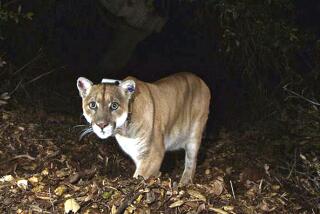Park Absolved in Death of Trainer
An investigation into the death of an elephant keeper at the San Diego Wild Animal Park uncovered no violations of state health and safety regulations, said a Cal-OSHA report released Wednesday; but, in fact, there are no state rules on the handling of animals.
The report comes one week after the San Diego Zoological Society instituted additional guidelines for elephant keepers at its parks, requiring at least two keepers in the elephant compound while training is going on.
Don Amos, district manager for the Occupational Safety and Health Administration, said that, although the park had not violated any safety regulations when Pamela Orsi was trampled by an Asian elephant in March, there are no state regulations regarding the handling of elephants for the park to have violated.
Amos said he plans to submit a recommendation to OSHA headquarters “that orders be developed regarding the handling of wild animals.”
“We can only enforce state laws, and I don’t know of any others covering this,” Amos said.
Orsi, who had been an elephant keeper for four years, was trampled by an elephant named Alice last month while she was in the yard attending to a second elephant. Orsi was not alone in the yard, but was out of sight of any other keepers.
The OSHA report recommended that the park “consider suspending elephant training, cleaning up, and other routine procedures unless two persons are immediately present.”
The report also said the Zoological Society, which runs the park and the San Diego Zoo, “should make its safety training program for elephant keepers much more specific and detailed.” Amos would not elaborate on what exact changes should be made.
Jeff Jouett, spokesman for the society, said he was unsurprised by most of the report, but would like other points to be clarified.
Although the report recommended that the elephant training program be “much more specific and detailed,” it also said the park already “has developed an extensive safety training (program) for the elephant keepers,” Jouett said.
Jouett said a March 28 memo to zookeepers identified several guidelines for elephant keepers:
* There will be no training in the exhibit without a minimum of two keepers immediately present. At least one of those two keepers must be an experienced elephant handler. Experienced is defined as having six to eight months’ training with elephants. All but one of the Wild Animal Park’s dozen trainers meet this qualification.
* Only experienced keepers are permited in the exhibit unattended. The OSHA report recommends that two persons be present even during cleaning up and “other routine procedures,” a provision zoo officials deemed unnecessary.
* Anyone training elephants in the compound must have approval from a supervisor.
* No one is to intervene at any time if two or more elephants are fighting.
One of the theories of how Orsi died was that she stepped between two fighting elephants. Later, eyewitnesses to the incident, none of whom were park officials, said Orsi was attending to one elephant when another caught Orsi unaware, knocked her down and trampled her.
The guidelines do allow a trainer to ward off an elephant taking an aggressive posture such as flaring its ears or lowering its head to charge, Jouett said.
The additional guidelines reflect the park’s commitment to a hands-on training policy for elephants, a policy that was questioned after Orsi’s death.
“The best way to take care of an elephant’s health and well-being is a hands-on elephant care program, and we will continue to do the best for the elephant,” Jouett said.
Several zoos across the country have been moving toward policies of less human interaction with their elephants, saying it is both safer for elephant trainers and a more natural environment for the animals.
Proponents of hands-on management say it is actually safer and easier for the trainers and the animals, since it allows the two to develop a working relationship.
More to Read
Sign up for Essential California
The most important California stories and recommendations in your inbox every morning.
You may occasionally receive promotional content from the Los Angeles Times.









